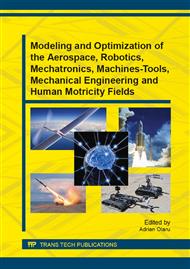[1]
Balance Mobility - How you control your balance, http: /balanceandmobility. com/patient_info/ balancecontrol, (October 2013).
Google Scholar
[2]
MedicineNet. com – Vestibular Balance Disorders, http: /www. medicinenet. com/vestibular_ balance_disorders/ (November 2013).
Google Scholar
[3]
M. I. Baritz, D. L. Cotoros, Conceptual Analysis of Ratio Between the Plantar Pressure and Insole Shape During Different Types of Gait, 14th Romanian Textiles and Leather Conference – CORTEP 2012, Sinaia, 6 - 8 September 2012, ISSN-L 2285-5378 (2012).
Google Scholar
[4]
U.S. Department of Health and Human Services - Balance Disorder, http: /www. nidcd. nih. gov/ health/balance/pages/balance_disorders (November 2013).
Google Scholar
[5]
M. Jose, T. Gomez - Evaluation of Idiopathic Scoliosis based on Alignment, Equilibrium and Stability: Gomez Orthotic Spine System, Torres, J Spine, 2: 5, Volume 2, ISSN: 2165-7939 JSP (2013).
DOI: 10.4172/2165-7939.1000149
Google Scholar
[6]
M. I. Baritz, Correlated and interconnected analyses for human walking and standing biomechanical behavior, ISPRA '10: Proceedings of the 9th Wseas International Conference on Signal Processing, Robotics and Automation Book Series: Mathematics and Computers in Science and Engineering, pp: 236-243, ISBN: 978-960-474-157-1 (2010).
Google Scholar
[7]
A. Panjan, N. Sarabon: Methods for the Evaluation of Human Balance Body, Sport Science Review, vol. XIX, no. 5-6 (2010).
Google Scholar
[8]
R. Schleer - Improvement of Body Balance and Gait Stability by Means of the Hallufix Foot Splint, Summary of a scientific study, http: /www. hallufix. org/ (January 2014).
Google Scholar
[9]
T. Q. Mckillip, eHow Contributor – How to Increase Body Balance, http: /www. ehow. com/ how_5340894_increase-body-balance. html, (January 2014).
Google Scholar
[10]
OrtoProfil – Reabilitation, http: /www. ortoprofil. ro/reabilitare (Mai 2013).
Google Scholar
[11]
M. I. Baritz, D. L. Cotoros, Oscillatory Movements Analysis at Knee Level, Applied Mechanics and Materials, vol. 436, pp.271-276 DOI: 10. 4028/www. scientific. net/AMM. 436. 271 (2013).
DOI: 10.4028/www.scientific.net/amm.436.271
Google Scholar
[12]
M. I. Baritz, D. L. Cotoros, The Influence of Plantar Surface Shape and Height upon the Support Basis and Bipodal Stability, 14th Romanian Textiles and Leather Conference – CORTEP 2012 Sinaia, 6 - 8 September 2012, ISSN-L 2285-5378 (2012).
Google Scholar
[13]
Kistler – Equipment Description, http: /www. kistler. com/ (December 2010).
Google Scholar
[14]
K. Seungsu, K. C. Hwan, Y. Bumjae, O. Sangrok - Stable Whole-body Motion Generation for Humanoid robots to Imitate Human Motions, Intelligent Robots and Systems, IROS, IEEE/RSJ, ISBN: 978-1-4244-3803-7, p.2518 – 2524, USA (2009).
DOI: 10.1109/iros.2009.5354271
Google Scholar
[15]
T. Sugihara, Y. Nakamura, Whole-body cooperative balancing of humanoid robot using COG Jacobian, Intelligent Robots and Systems IEEE/RSJ International Conference, volume 3, ISBN: 0-7803-7398-7, p.2575 – 2580, USA (2002).
DOI: 10.1109/irds.2002.1041658
Google Scholar
[16]
R. Hopcroft, M. Skinner - Human Vibration, Published by Air Operations Division DSTO Defence Science and Technology Organisation, Australia (2005).
Google Scholar
[17]
I. Serban, Studies and research on environmental influence on the stability and human locomotion, Ph. D. Thesis, Brasov, Romania (2011).
Google Scholar
[18]
I. Serban, I.C. Rosca, M.I. Baritz, Sound Frequency Influence On The Human Body Stability, Environment Engineering Management Journal, Iasi, Romania (2013).
Google Scholar


